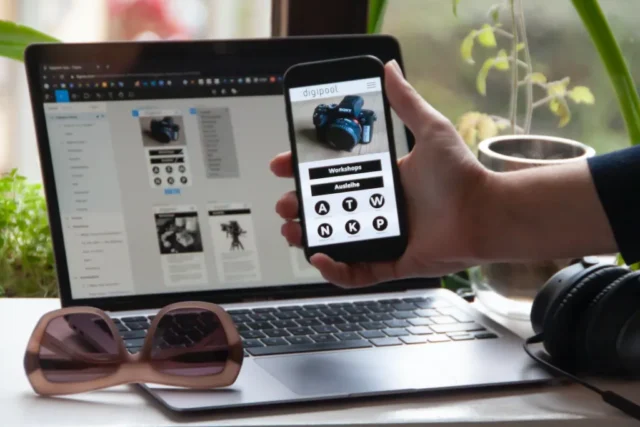In an increasingly digital world, providing a seamless user experience (UX) across both web and mobile platforms is crucial for businesses aiming to engage their audience effectively. With users accessing content from various devices, it’s essential to ensure that the experience is consistent, intuitive, and enjoyable. Here’s how to create a seamless UX across web and mobile.

Table of Contents
Toggle1. Responsive Design
A responsive design adapts to various screen sizes and orientations, ensuring that your website looks and functions well on all devices.
- Fluid Grids and Layouts: Use flexible grid layouts that resize based on the screen size. This ensures content is displayed appropriately, regardless of whether the user is on a desktop or mobile device.
- Media Queries: Implement CSS media queries to apply different styles based on device characteristics. This allows you to adjust fonts, images, and layout elements to optimize the viewing experience.
- Testing: Regularly test your website on different devices and browsers to identify any inconsistencies and ensure a smooth experience.
2. Consistent Branding
Maintaining consistent branding across platforms helps users feel familiar and comfortable with your brand.
- Visual Identity: Use the same color schemes, typography, and logo placements on both web and mobile versions. Consistency reinforces brand recognition and trust.
- Voice and Tone: Ensure that the messaging and tone of voice remain consistent across platforms. Whether a user interacts with your brand on the web or mobile, they should feel they are engaging with the same entity.
3. Streamlined Navigation
A clear and intuitive navigation structure is essential for guiding users through your content seamlessly.
- Simplified Menus: Keep navigation menus simple and organized. On mobile, consider using hamburger menus to save space while providing easy access to important sections.
- Breadcrumbs: Implement breadcrumb navigation on both platforms to help users understand their location within the site and easily backtrack if necessary.
- Search Functionality: Provide a prominent search feature that allows users to find content quickly, especially on mobile devices where scrolling can be cumbersome.
4. Optimized Loading Speed
Loading speed is critical for user retention and satisfaction, particularly on mobile devices where users expect quick access to information.
- Image Optimization: Compress images and use appropriate formats (like WebP) to reduce load times without sacrificing quality.
- Minimize HTTP Requests: Combine CSS and JavaScript files and use asynchronous loading to reduce the number of requests and improve speed.
- Leverage Caching: Implement browser caching to store frequently accessed data, allowing for faster load times on repeat visits.
5. Touch-Friendly Interactions
Mobile users rely on touch interactions, so it’s essential to design touch-friendly elements.
- Button Size and Spacing: Ensure buttons are large enough to be easily tapped, with adequate spacing to prevent accidental clicks.
- Gestures: Incorporate touch gestures (like swipes and pinches) to enhance navigation and interactions, making the experience more natural for mobile users.
- Feedback: Provide visual feedback for interactions, such as highlighting buttons when tapped or showing loading animations during transitions.
6. Content Adaptation
Tailor content for each platform while ensuring that the core message remains consistent.
- Prioritize Content: Determine which content is most important for mobile users and prioritize it. Mobile screens have limited space, so highlight key information upfront.
- Readability: Use legible font sizes and spacing for mobile users. Ensure that text is easy to read without zooming in, and avoid excessive scrolling.
- Shorten Forms: Simplify forms for mobile users by reducing the number of fields and using auto-fill options where possible.
7. Seamless Integration of Features
Integrate features that enhance the user experience across platforms.
- Account Syncing: Allow users to create accounts and sync their preferences and data across devices, so they can pick up where they left off.
- Push Notifications: Use push notifications on mobile to engage users while respecting their preferences for frequency and content.
- Cross-Platform Functionality: Ensure features like shopping carts or saved items are consistent and accessible on both web and mobile versions.
8. Regular User Testing and Feedback
Continuous improvement is essential for maintaining a seamless experience.
- User Testing: Conduct regular usability tests to identify pain points and gather feedback on both web and mobile experiences.
- Analytics: Utilize tools like Google Analytics to monitor user behavior and engagement metrics across platforms. Analyze bounce rates, session duration, and conversion rates to inform improvements.
- Feedback Loops: Encourage users to provide feedback through surveys or comment sections. Use this information to make iterative enhancements.
Conclusion
Creating a seamless user experience across web and mobile requires thoughtful planning, consistent branding, intuitive navigation, and continuous optimization. By prioritizing responsive design, content adaptation, and user-centric features, businesses can engage their audience effectively, regardless of the device they use. Remember that user experience is an ongoing process; regularly gather feedback and make necessary adjustments to ensure that your website remains effective and enjoyable for all users.


No responses yet